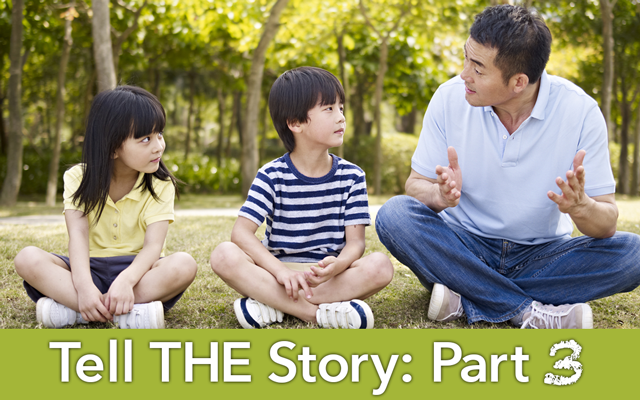Tell THE Story: Part 3


In part two, we covered the “how” of prepping Mom for the missionary-tested education method, Tell THE Story (TTS). This article will dive into helping the children engage in the stories (with the links we’ve referenced for further study provided once again at the end).
Prepping the Children for the Story
Repetition and accuracy are key cornerstones in TTS. Children especially learn best with a repetitive cue, word, or habit that primes their brains for what is coming. Therefore, I encourage you to be very methodical when using TTS. Cue your kids that it’s time for a fun story with something like, “I’m going to tell a story, and I need you to listen very closely because you are going to tell it after I do. So this is my story.” And then proceed with the narrative, after which you will again repeat “And that is my story,” to signal you are done.
Children Retelling the Story
As the children retell the story, the most important rules for success are not for them but for you.
Perfection is NOT the goal. Tell me, how many times did you get this story wrong while memorizing it? Is it honestly realistic to expect a child to get it perfect after hearing it only once? The entire purpose of retelling is so the children are hearing the story again. Retelling it for themselves also enforces a different set of learning skills than simply listening. They heard it once when you told it; now, they are actually learning it for the first time when they tell it. It is how the brain of any healthy, normal child works and why TTS is so powerful.
Keep it fun. This is not a test. You are not a failure if your children get some of the facts wrong. In a gentle, friendly manner give them the right answer.
Retelling with Errors
This is most children’s favorite part: they get to tell Mom she is wrong. And if you’ve kept it light-hearted, this is where parent and child’s hearts begin to engage with one another. The children laugh at the ridiculousness of Mom saying David killed a flying wombat and Jesus walked on a sea of milkshakes instead of water. But even here the child is using important learning skills. By confusing important story elements, the child has to remember what was right and thus the crucial elements of the story are stamped in bold on their memories.
Interactive Questions
Again, the purpose of the questions, as listed in part one, are to cause children to reflect on the story. They are open-ended by design to encourage children to think and articulate their own perceptions of what they just learned. It also personally engages
them in the story by asking them what they liked and didn’t like, as well as causing them to realize these aren’t just stories but are actual truths that apply to them on a very personal, relevant level.
Storytelling has been and will always be the most cherished and natural bond to learning. It’s made a great change in my teaching, and I would highly encourage you to check out the links below for more on TTS. Happy teaching, fellow homeschoolers!
TTS Overview PDF
Live audio of TTS training with Candice Brooks
Kenzi Knapp is a follower of Christ, homeschool graduate and student of history. A fourth generation Missourian she enjoys writing about daily life enrolled in Gods great course of faith and His story throughout the ages at her blog, Honey Rock Hills.









































